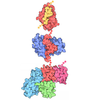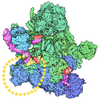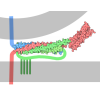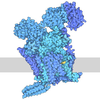+ データを開く
データを開く
- 基本情報
基本情報
| 登録情報 | データベース: PDB / ID: 7qy7 | |||||||||||||||||||||
|---|---|---|---|---|---|---|---|---|---|---|---|---|---|---|---|---|---|---|---|---|---|---|
| タイトル | Proteasome-ZFAND5 Complex Z-A state | |||||||||||||||||||||
 要素 要素 |
| |||||||||||||||||||||
 キーワード キーワード | STRUCTURAL PROTEIN / proteasome / ZFAND5 / Activation | |||||||||||||||||||||
| 機能・相同性 |  機能・相同性情報 機能・相同性情報Impaired BRCA2 translocation to the nucleus / Impaired BRCA2 binding to SEM1 (DSS1) / host-mediated perturbation of viral transcription / 加水分解酵素; プロテアーゼ; ペプチド結合加水分解酵素; オメガペプチターゼ / integrator complex / proteasome accessory complex / meiosis I / purine ribonucleoside triphosphate binding / proteasome regulatory particle / cytosolic proteasome complex ...Impaired BRCA2 translocation to the nucleus / Impaired BRCA2 binding to SEM1 (DSS1) / host-mediated perturbation of viral transcription / 加水分解酵素; プロテアーゼ; ペプチド結合加水分解酵素; オメガペプチターゼ / integrator complex / proteasome accessory complex / meiosis I / purine ribonucleoside triphosphate binding / proteasome regulatory particle / cytosolic proteasome complex / positive regulation of proteasomal protein catabolic process / proteasome-activating activity / proteasome regulatory particle, lid subcomplex / proteasome regulatory particle, base subcomplex / protein K63-linked deubiquitination / metal-dependent deubiquitinase activity / Regulation of ornithine decarboxylase (ODC) / Proteasome assembly / Cross-presentation of soluble exogenous antigens (endosomes) / proteasome core complex / Homologous DNA Pairing and Strand Exchange / Defective homologous recombination repair (HRR) due to BRCA1 loss of function / Defective HDR through Homologous Recombination Repair (HRR) due to PALB2 loss of BRCA1 binding function / Defective HDR through Homologous Recombination Repair (HRR) due to PALB2 loss of BRCA2/RAD51/RAD51C binding function / Resolution of D-loop Structures through Synthesis-Dependent Strand Annealing (SDSA) / Somitogenesis / Resolution of D-loop Structures through Holliday Junction Intermediates / K63-linked deubiquitinase activity / Impaired BRCA2 binding to RAD51 / proteasome binding / regulation of protein catabolic process / myofibril / proteasome storage granule / Presynaptic phase of homologous DNA pairing and strand exchange / blastocyst development / polyubiquitin modification-dependent protein binding / protein deubiquitination / immune system process / NF-kappaB binding / proteasome endopeptidase complex / proteasome core complex, beta-subunit complex / endopeptidase activator activity / proteasome assembly / threonine-type endopeptidase activity / mRNA export from nucleus / proteasome core complex, alpha-subunit complex / enzyme regulator activity / regulation of proteasomal protein catabolic process / proteasome complex / proteolysis involved in protein catabolic process / sarcomere / Regulation of activated PAK-2p34 by proteasome mediated degradation / Autodegradation of Cdh1 by Cdh1:APC/C / APC/C:Cdc20 mediated degradation of Securin / N-glycan trimming in the ER and Calnexin/Calreticulin cycle / Asymmetric localization of PCP proteins / Ubiquitin-dependent degradation of Cyclin D / SCF-beta-TrCP mediated degradation of Emi1 / NIK-->noncanonical NF-kB signaling / stem cell differentiation / TNFR2 non-canonical NF-kB pathway / AUF1 (hnRNP D0) binds and destabilizes mRNA / Vpu mediated degradation of CD4 / Assembly of the pre-replicative complex / Ubiquitin-Mediated Degradation of Phosphorylated Cdc25A / Degradation of DVL / Dectin-1 mediated noncanonical NF-kB signaling / negative regulation of inflammatory response to antigenic stimulus / Cdc20:Phospho-APC/C mediated degradation of Cyclin A / lipopolysaccharide binding / P-body / Degradation of AXIN / Hh mutants are degraded by ERAD / Activation of NF-kappaB in B cells / Degradation of GLI1 by the proteasome / G2/M Checkpoints / Hedgehog ligand biogenesis / Defective CFTR causes cystic fibrosis / Autodegradation of the E3 ubiquitin ligase COP1 / GSK3B and BTRC:CUL1-mediated-degradation of NFE2L2 / Regulation of RUNX3 expression and activity / Negative regulation of NOTCH4 signaling / Hedgehog 'on' state / Vif-mediated degradation of APOBEC3G / APC/C:Cdh1 mediated degradation of Cdc20 and other APC/C:Cdh1 targeted proteins in late mitosis/early G1 / FBXL7 down-regulates AURKA during mitotic entry and in early mitosis / Degradation of GLI2 by the proteasome / GLI3 is processed to GLI3R by the proteasome / double-strand break repair via homologous recombination / MAPK6/MAPK4 signaling / Degradation of beta-catenin by the destruction complex / Oxygen-dependent proline hydroxylation of Hypoxia-inducible Factor Alpha / double-strand break repair via nonhomologous end joining / ABC-family proteins mediated transport / HDR through Homologous Recombination (HRR) / CDK-mediated phosphorylation and removal of Cdc6 / CLEC7A (Dectin-1) signaling / SCF(Skp2)-mediated degradation of p27/p21 / response to virus / FCERI mediated NF-kB activation 類似検索 - 分子機能 | |||||||||||||||||||||
| 生物種 |  Homo sapiens (ヒト) Homo sapiens (ヒト) | |||||||||||||||||||||
| 手法 | 電子顕微鏡法 / 単粒子再構成法 / クライオ電子顕微鏡法 / 解像度: 4.7 Å | |||||||||||||||||||||
 データ登録者 データ登録者 | Zhu, Y. / Lu, Y. | |||||||||||||||||||||
| 資金援助 | 1件
| |||||||||||||||||||||
 引用 引用 |  ジャーナル: Mol Cell / 年: 2023 ジャーナル: Mol Cell / 年: 2023タイトル: Molecular mechanism for activation of the 26S proteasome by ZFAND5. 著者: Donghoon Lee / Yanan Zhu / Louis Colson / Xiaorong Wang / Siyi Chen / Emre Tkacik / Lan Huang / Qi Ouyang / Alfred L Goldberg / Ying Lu /   要旨: Various hormones, kinases, and stressors (fasting, heat shock) stimulate 26S proteasome activity. To understand how its capacity to degrade ubiquitylated proteins can increase, we studied mouse ...Various hormones, kinases, and stressors (fasting, heat shock) stimulate 26S proteasome activity. To understand how its capacity to degrade ubiquitylated proteins can increase, we studied mouse ZFAND5, which promotes protein degradation during muscle atrophy. Cryo-electron microscopy showed that ZFAND5 induces large conformational changes in the 19S regulatory particle. ZFAND5's AN1 Zn-finger domain interacts with the Rpt5 ATPase and its C terminus with Rpt1 ATPase and Rpn1, a ubiquitin-binding subunit. Upon proteasome binding, ZFAND5 widens the entrance of the substrate translocation channel, yet it associates only transiently with the proteasome. Dissociation of ZFAND5 then stimulates opening of the 20S proteasome gate. Using single-molecule microscopy, we showed that ZFAND5 binds ubiquitylated substrates, prolongs their association with proteasomes, and increases the likelihood that bound substrates undergo degradation, even though ZFAND5 dissociates before substrate deubiquitylation. These changes in proteasome conformation and reaction cycle can explain the accelerated degradation and suggest how other proteasome activators may stimulate proteolysis. | |||||||||||||||||||||
| 履歴 |
|
- 構造の表示
構造の表示
| 構造ビューア | 分子:  Molmil Molmil Jmol/JSmol Jmol/JSmol |
|---|
- ダウンロードとリンク
ダウンロードとリンク
- ダウンロード
ダウンロード
| PDBx/mmCIF形式 |  7qy7.cif.gz 7qy7.cif.gz | 2.2 MB | 表示 |  PDBx/mmCIF形式 PDBx/mmCIF形式 |
|---|---|---|---|---|
| PDB形式 |  pdb7qy7.ent.gz pdb7qy7.ent.gz | 1.8 MB | 表示 |  PDB形式 PDB形式 |
| PDBx/mmJSON形式 |  7qy7.json.gz 7qy7.json.gz | ツリー表示 |  PDBx/mmJSON形式 PDBx/mmJSON形式 | |
| その他 |  その他のダウンロード その他のダウンロード |
-検証レポート
| 文書・要旨 |  7qy7_validation.pdf.gz 7qy7_validation.pdf.gz | 1.8 MB | 表示 |  wwPDB検証レポート wwPDB検証レポート |
|---|---|---|---|---|
| 文書・詳細版 |  7qy7_full_validation.pdf.gz 7qy7_full_validation.pdf.gz | 2.2 MB | 表示 | |
| XML形式データ |  7qy7_validation.xml.gz 7qy7_validation.xml.gz | 358.9 KB | 表示 | |
| CIF形式データ |  7qy7_validation.cif.gz 7qy7_validation.cif.gz | 539.3 KB | 表示 | |
| アーカイブディレクトリ |  https://data.pdbj.org/pub/pdb/validation_reports/qy/7qy7 https://data.pdbj.org/pub/pdb/validation_reports/qy/7qy7 ftp://data.pdbj.org/pub/pdb/validation_reports/qy/7qy7 ftp://data.pdbj.org/pub/pdb/validation_reports/qy/7qy7 | HTTPS FTP |
-関連構造データ
| 関連構造データ | 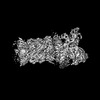 14209MC 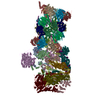 7qxnC 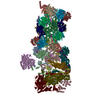 7qxpC 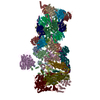 7qxuC 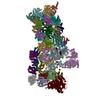 7qxwC 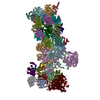 7qxxC 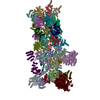 7qyaC 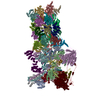 7qybC M: このデータのモデリングに利用したマップデータ C: 同じ文献を引用 ( |
|---|---|
| 類似構造データ | 類似検索 - 機能・相同性  F&H 検索 F&H 検索 |
- リンク
リンク
- 集合体
集合体
| 登録構造単位 | 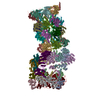
|
|---|---|
| 1 |
|
- 要素
要素
-26S proteasome ... , 13種, 13分子 abcdefUVWXYZE
| #1: タンパク質 | 分子量: 42995.359 Da / 分子数: 1 / 由来タイプ: 天然 / 由来: (天然)  Homo sapiens (ヒト) / 参照: UniProt: Q9UNM6 Homo sapiens (ヒト) / 参照: UniProt: Q9UNM6 |
|---|---|
| #2: タンパク質 | 分子量: 40781.590 Da / 分子数: 1 / 由来タイプ: 天然 / 由来: (天然)  Homo sapiens (ヒト) / 参照: UniProt: P55036 Homo sapiens (ヒト) / 参照: UniProt: P55036 |
| #3: タンパク質 | 分子量: 34488.824 Da / 分子数: 1 / 由来タイプ: 天然 / 由来: (天然)  Homo sapiens (ヒト) Homo sapiens (ヒト)参照: UniProt: O00487, 加水分解酵素; プロテアーゼ; ペプチド結合加水分解酵素; オメガペプチターゼ |
| #4: タンパク質 | 分子量: 39536.676 Da / 分子数: 1 / 由来タイプ: 天然 / 由来: (天然)  Homo sapiens (ヒト) / 参照: UniProt: P48556 Homo sapiens (ヒト) / 参照: UniProt: P48556 |
| #5: タンパク質 | 分子量: 8284.611 Da / 分子数: 1 / 由来タイプ: 天然 / 由来: (天然)  Homo sapiens (ヒト) / 参照: UniProt: P60896 Homo sapiens (ヒト) / 参照: UniProt: P60896 |
| #6: タンパク質 | 分子量: 100313.625 Da / 分子数: 1 / 由来タイプ: 天然 / 由来: (天然)  Homo sapiens (ヒト) / 参照: UniProt: Q13200 Homo sapiens (ヒト) / 参照: UniProt: Q13200 |
| #7: タンパク質 | 分子量: 105958.234 Da / 分子数: 1 / 由来タイプ: 天然 / 由来: (天然)  Homo sapiens (ヒト) / 参照: UniProt: Q99460 Homo sapiens (ヒト) / 参照: UniProt: Q99460 |
| #8: タンパク質 | 分子量: 60935.297 Da / 分子数: 1 / 由来タイプ: 天然 / 由来: (天然)  Homo sapiens (ヒト) / 参照: UniProt: O43242 Homo sapiens (ヒト) / 参照: UniProt: O43242 |
| #9: タンパク質 | 分子量: 52979.359 Da / 分子数: 1 / 由来タイプ: 天然 / 由来: (天然)  Homo sapiens (ヒト) / 参照: UniProt: O00232 Homo sapiens (ヒト) / 参照: UniProt: O00232 |
| #10: タンパク質 | 分子量: 47526.688 Da / 分子数: 1 / 由来タイプ: 天然 / 由来: (天然)  Homo sapiens (ヒト) / 参照: UniProt: O00231 Homo sapiens (ヒト) / 参照: UniProt: O00231 |
| #11: タンパク質 | 分子量: 45592.285 Da / 分子数: 1 / 由来タイプ: 天然 / 由来: (天然)  Homo sapiens (ヒト) / 参照: UniProt: Q15008 Homo sapiens (ヒト) / 参照: UniProt: Q15008 |
| #12: タンパク質 | 分子量: 37086.441 Da / 分子数: 1 / 由来タイプ: 天然 / 由来: (天然)  Homo sapiens (ヒト) / 参照: UniProt: P51665 Homo sapiens (ヒト) / 参照: UniProt: P51665 |
| #17: タンパク質 | 分子量: 45867.027 Da / 分子数: 1 / 由来タイプ: 天然 / 由来: (天然)  Homo sapiens (ヒト) / 参照: UniProt: A0A087X2I1 Homo sapiens (ヒト) / 参照: UniProt: A0A087X2I1 |
-26S protease regulatory subunit ... , 4種, 4分子 ABDF
| #13: タンパク質 | 分子量: 48700.805 Da / 分子数: 1 / 由来タイプ: 天然 / 由来: (天然)  Homo sapiens (ヒト) / 参照: UniProt: P35998 Homo sapiens (ヒト) / 参照: UniProt: P35998 |
|---|---|
| #14: タンパク質 | 分子量: 49260.504 Da / 分子数: 1 / 由来タイプ: 天然 / 由来: (天然)  Homo sapiens (ヒト) / 参照: UniProt: P62191 Homo sapiens (ヒト) / 参照: UniProt: P62191 |
| #16: タンパク質 | 分子量: 47426.141 Da / 分子数: 1 / 由来タイプ: 天然 / 由来: (天然)  Homo sapiens (ヒト) / 参照: UniProt: P43686 Homo sapiens (ヒト) / 参照: UniProt: P43686 |
| #18: タンパク質 | 分子量: 49266.457 Da / 分子数: 1 / 由来タイプ: 天然 / 由来: (天然)  Homo sapiens (ヒト) / 参照: UniProt: P17980 Homo sapiens (ヒト) / 参照: UniProt: P17980 |
-タンパク質 , 2種, 3分子 CLl
| #15: タンパク質 | 分子量: 44294.395 Da / 分子数: 1 / 由来タイプ: 天然 / 由来: (天然)  Homo sapiens (ヒト) / 参照: UniProt: A0A6D2XG74 Homo sapiens (ヒト) / 参照: UniProt: A0A6D2XG74 |
|---|---|
| #24: タンパク質 | 分子量: 30150.277 Da / 分子数: 2 / 由来タイプ: 天然 / 由来: (天然)  Homo sapiens (ヒト) / 参照: UniProt: P25786 Homo sapiens (ヒト) / 参照: UniProt: P25786 |
-Proteasome subunit alpha type- ... , 6種, 12分子 GgHhIiJjKkMm
| #19: タンパク質 | 分子量: 27301.262 Da / 分子数: 2 / 由来タイプ: 天然 / 由来: (天然)  Homo sapiens (ヒト) / 参照: UniProt: P60900 Homo sapiens (ヒト) / 参照: UniProt: P60900#20: タンパク質 | 分子量: 25796.338 Da / 分子数: 2 / 由来タイプ: 天然 / 由来: (天然)  Homo sapiens (ヒト) / 参照: UniProt: P25787 Homo sapiens (ヒト) / 参照: UniProt: P25787#21: タンパク質 | 分子量: 29394.648 Da / 分子数: 2 / 由来タイプ: 天然 / 由来: (天然)  Homo sapiens (ヒト) / 参照: UniProt: P25789 Homo sapiens (ヒト) / 参照: UniProt: P25789#22: タンパク質 | 分子量: 27798.695 Da / 分子数: 2 / 由来タイプ: 天然 / 由来: (天然)  Homo sapiens (ヒト) / 参照: UniProt: O14818 Homo sapiens (ヒト) / 参照: UniProt: O14818#23: タンパク質 | 分子量: 26304.779 Da / 分子数: 2 / 由来タイプ: 天然 / 由来: (天然)  Homo sapiens (ヒト) / 参照: UniProt: P28066 Homo sapiens (ヒト) / 参照: UniProt: P28066#25: タンパク質 | 分子量: 28338.057 Da / 分子数: 2 / 由来タイプ: 天然 / 由来: (天然)  Homo sapiens (ヒト) / 参照: UniProt: P25788 Homo sapiens (ヒト) / 参照: UniProt: P25788 |
|---|
-Proteasome subunit beta type- ... , 7種, 14分子 NnOoPpQqRrSsTt
| #26: タンパク質 | 分子量: 25246.455 Da / 分子数: 2 / 由来タイプ: 天然 / 由来: (天然)  Homo sapiens (ヒト) / 参照: UniProt: P28072, proteasome endopeptidase complex Homo sapiens (ヒト) / 参照: UniProt: P28072, proteasome endopeptidase complex#27: タンパク質 | 分子量: 29869.223 Da / 分子数: 2 / 由来タイプ: 天然 / 由来: (天然)  Homo sapiens (ヒト) / 参照: UniProt: Q99436, proteasome endopeptidase complex Homo sapiens (ヒト) / 参照: UniProt: Q99436, proteasome endopeptidase complex#28: タンパク質 | 分子量: 22841.701 Da / 分子数: 2 / 由来タイプ: 天然 / 由来: (天然)  Homo sapiens (ヒト) / 参照: UniProt: P49720, proteasome endopeptidase complex Homo sapiens (ヒト) / 参照: UniProt: P49720, proteasome endopeptidase complex#29: タンパク質 | 分子量: 22864.277 Da / 分子数: 2 / 由来タイプ: 天然 / 由来: (天然)  Homo sapiens (ヒト) / 参照: UniProt: P49721, proteasome endopeptidase complex Homo sapiens (ヒト) / 参照: UniProt: P49721, proteasome endopeptidase complex#30: タンパク質 | 分子量: 28379.053 Da / 分子数: 2 / 由来タイプ: 天然 / 由来: (天然)  Homo sapiens (ヒト) / 参照: UniProt: P28074, proteasome endopeptidase complex Homo sapiens (ヒト) / 参照: UniProt: P28074, proteasome endopeptidase complex#31: タンパク質 | 分子量: 26391.201 Da / 分子数: 2 / 由来タイプ: 天然 / 由来: (天然)  Homo sapiens (ヒト) / 参照: UniProt: P20618 Homo sapiens (ヒト) / 参照: UniProt: P20618#32: タンパク質 | 分子量: 29099.986 Da / 分子数: 2 / 由来タイプ: 天然 / 由来: (天然)  Homo sapiens (ヒト) / 参照: UniProt: P28070 Homo sapiens (ヒト) / 参照: UniProt: P28070 |
|---|
-非ポリマー , 2種, 6分子 
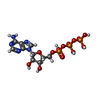

| #33: 化合物 | ChemComp-ZN / |
|---|---|
| #34: 化合物 | ChemComp-ATP / |
-詳細
| 研究の焦点であるリガンドがあるか | Y |
|---|---|
| Has protein modification | Y |
-実験情報
-実験
| 実験 | 手法: 電子顕微鏡法 |
|---|---|
| EM実験 | 試料の集合状態: PARTICLE / 3次元再構成法: 単粒子再構成法 |
- 試料調製
試料調製
| 構成要素 | 名称: human proteasome zfand5 complex Z-A state / タイプ: COMPLEX / Entity ID: #1-#32 / 由来: NATURAL |
|---|---|
| 由来(天然) | 生物種:  Homo sapiens (ヒト) Homo sapiens (ヒト) |
| 緩衝液 | pH: 7 |
| 試料 | 濃度: 2 mg/ml / 包埋: NO / シャドウイング: NO / 染色: NO / 凍結: YES |
| 急速凍結 | 凍結剤: ETHANE |
- 電子顕微鏡撮影
電子顕微鏡撮影
| 実験機器 |  モデル: Titan Krios / 画像提供: FEI Company |
|---|---|
| 顕微鏡 | モデル: FEI TITAN KRIOS |
| 電子銃 | 電子線源:  FIELD EMISSION GUN / 加速電圧: 300 kV / 照射モード: FLOOD BEAM FIELD EMISSION GUN / 加速電圧: 300 kV / 照射モード: FLOOD BEAM |
| 電子レンズ | モード: BRIGHT FIELD / 最大 デフォーカス(公称値): 2500 nm / 最小 デフォーカス(公称値): 800 nm |
| 撮影 | 電子線照射量: 46.6 e/Å2 フィルム・検出器のモデル: GATAN K2 QUANTUM (4k x 4k) |
- 解析
解析
| ソフトウェア | 名称: PHENIX / バージョン: 1.11.1_2575: / 分類: 精密化 | ||||||||||||||||||||||||
|---|---|---|---|---|---|---|---|---|---|---|---|---|---|---|---|---|---|---|---|---|---|---|---|---|---|
| EMソフトウェア | 名称: PHENIX / カテゴリ: モデル精密化 | ||||||||||||||||||||||||
| CTF補正 | タイプ: PHASE FLIPPING AND AMPLITUDE CORRECTION | ||||||||||||||||||||||||
| 3次元再構成 | 解像度: 4.7 Å / 解像度の算出法: FSC 0.143 CUT-OFF / 粒子像の数: 34363 / 対称性のタイプ: POINT | ||||||||||||||||||||||||
| 拘束条件 |
|
 ムービー
ムービー コントローラー
コントローラー






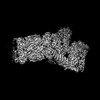



 PDBj
PDBj




